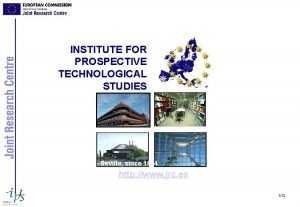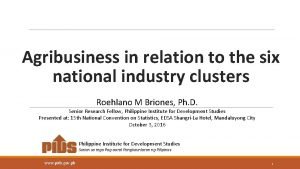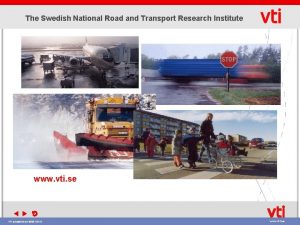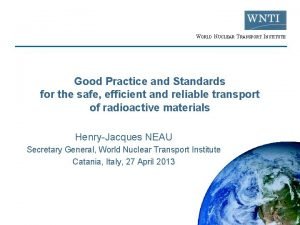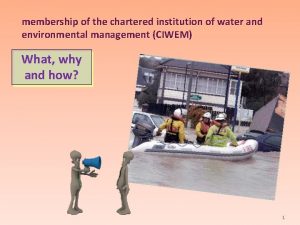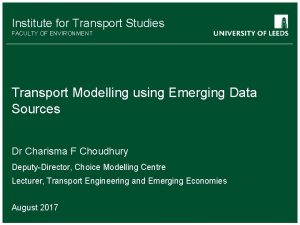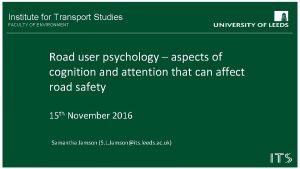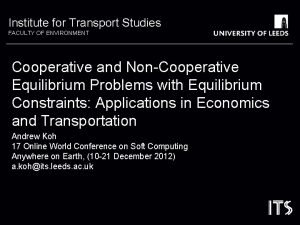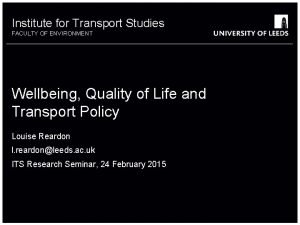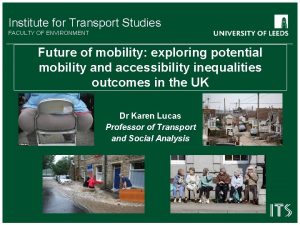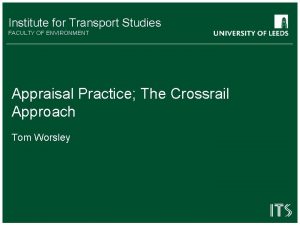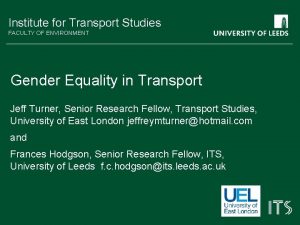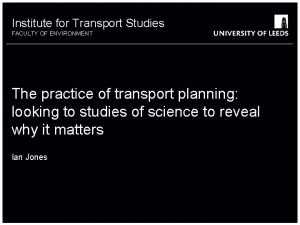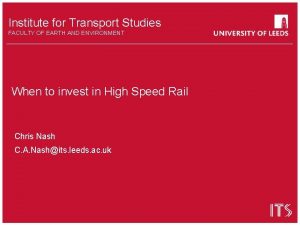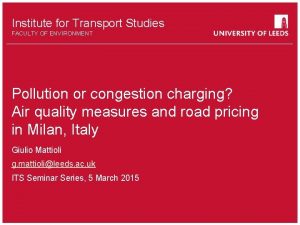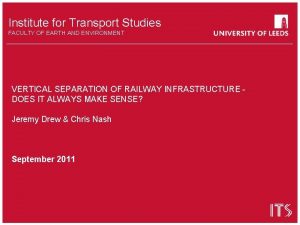Institute for Transport Studies FACULTY OF ENVIRONMENT Modelling

















- Slides: 17

Institute for Transport Studies FACULTY OF ENVIRONMENT Modelling production-consumption flows of goods in Europe: the trade model within Transtools 3 Gerard de Jong, Reto Tanner Institute for Transport Studies, University of Leeds Jeppe Rich, Mikkel Thorhauge, Otto Anker Nielsen DTU Technical University of Denmark John Bates

Contents 1. The Transtools 3 freight transport model 2. Model specifications 3. Data 4. Estimation results and elasticities 5. Conclusions and further work

Position of the Transtools 3 freight model Transtools 1 and 2 were EU-wide models for passenger and freight transport for the European Commission DG MOVE A consortium led by DTU is now developing a new model for passenger and freight transport at the European scale for DG MOVE These are all transport-network-based models (heavy; relatively detailed networks) The Transtools 3 freight transport model follows a different approach than before Transtools 3 zones are NUTS 3 or subdivisions of those and the commodity classification is NST/R-1 3

Structure of the overall Transtools 3 freight transport model (follows ADA) 4

The trade model within Transtools 3 • Focus in Transtools 3 was on estimating transport chain choice models on disaggregate data • We tried to keep trade model relatively simple and to base it on the limited amount of available data • No SCGE or I/O model, but a gravity-based trade model • But have to tackle a number of issues: • Relative costs • Many trade flows between countries are zero

From my lecture notes: freight transport distribution models Type of model Gravity Input-output SCGE Advantages Limited data requirements Some policy effects through transport cost function Disadvantages Limited scope for including explanatory factors and policy effects Limited number of calibration parameters (which rules out a good fit to the data) Link to the economy Need input-output table, Can give land use preferably multi-regional Interactions Restrictive assumptions if fixed Policy effects if elastic coefficients Need conversion from values to tonnes Link to the economy Needs as least as much data as Based on economic theory input-output Can give land use (and Includes many assumptions (e. g. other) interactions equilibrium, cost functions) Can give policy effects Needs conversion from values to tonnes Still in (academic) development phase

Gravity for trade: relative cost • Modern theoretical literature on gravity-based trade models: • trade between two countries is not simply determined by the absolute trade costs between the two countries, but by the relative trade cost (=the trade cost of country i from importer j relative to its overall trade cost for all the countries from which it imports). • In an empirical gravity model, this can be taken into account by adding multilateral resistance terms. • However a simpler method is to use importer or exporter fixed effects • But then GDP of country i or j has no impact anymore • Or random effects model

Fixed effects model Model with fixed effects at the level of destination countries j :

Random effects model Model with random effects:

Countries with zero trade • In the data many country-country flows (by NST/R 1) are zero • Actually two decisions: • Whether to export to a country at all • How much trade if trade • Heckman model (two steps): • Discrete participation (selection) equation • Continuous demand equation

Heckman model The demand equation is: The selection equation is:

Data for estimation Dependent variable: • PC matrices in tonnes by NUTS 3 zones for 2010 from ETISplus project (‘synthetic’ or ‘modelled’) • Aggregation to country level (‘observed’) • We tried both in estimation, but prefer latter, since this is based on observed data, not a synthetic split. Independent variables: • GDP and population from World Bank -> GDP and GDP/capita • Crow-fly distance (will be replaced by generalised costs) -> distance splines • Dummy variables on barriers to trade, trade blocks, etc. : • EU or EFTA member • Euro as currency • Neighbours • Same language

Estimations • By NST/R-1 commodity: 10 submodels • For NUTS 3 zones and for countries • Linear and double logarithmic • Standard absolute costs, fixed effects (2 x), random effects • With and without participation equation (Heckman) We prefer: Random effects model estimated on country data: • Observed data • Account for relative costs • Full effect of GDP changes • Deleting zero flows is acceptable (Linders and de Groot, 2006; and our data)

Random effects model estimation results for agricultural products (n=6388) variable coefficient t-ratio Distance 100 -300 km 1. 327 0. 76 Distance 300 -500 km -2. 881 -2. 59 Distance 500 -1000 km -2. 025 -4. 62 Distance 1000 -2000 km -2. 200 -8. 90 Distance >2000 km -0. 339 -4. 64 Ln(origin GDP) 0. 824 39. 12 Ln(destination GDP) 0. 598 12. 43 Ln(origin GDP/cap) -0. 274 -8. 37 Ln(destination GDP/cap) -0. 111 -1. 64 Both member EU/EFTA 0. 743 5. 07 Both Euro 0. 596 3. 36 Neighbours 1. 743 7. 03 Same language 0. 742 5. 64 Constant -9. 103 -4. 88

GDP elasticities of trade flows in tonnes from random effects model Product type 0 Agricultural prod. & live animals 1. 04 1 Foodstuffs and animal fodder 1. 21 2 Solid mineral fuels 0. 28 3 Petroleum products 1. 13 4 Ores and metal waste 0. 73 5 Metal products 1. 22 6 Crude and manufactured minerals 0. 96 7 Fertilisers -0. 42 8 Chemicals 2. 04 9 Machinery 1. 87

Implementation of trade model within Transtools 3 • In the application of the trade model, we only use the GDP and GDP per capita elasticities • We assume that distances and the dummies do not change • The model however can also be used however to calculate the trade effects of changes in the composition of the European Union, such as Brexit, or the EURO zone • The trade model then reads in the 2010 base PC matrix (from ETIS+) and income and population changes per zone.

Conclusions and further work • In Transtools 3, future year PC matrices from the trade model are combined with the disaggregate transport chain choice model. • We estimated fixed effects, random effects and Heckman models on zonal and on country data • We prefer the random effects model on country data • This uses distance between countries • We are working on replacing distance by a logsum variable from the transport chain choice model • so that there will also be an influence of transport costs on the pattern of PC flows
 Herszon kherson maritime college of merchant marine fleet
Herszon kherson maritime college of merchant marine fleet Paradigm shift from women studies to gender studies
Paradigm shift from women studies to gender studies Sodium potasium pump
Sodium potasium pump Primary vs secondary active transport
Primary vs secondary active transport Now answer the questions
Now answer the questions Passive transport vs active transport venn diagram
Passive transport vs active transport venn diagram Unlike passive transport, active transport requires *
Unlike passive transport, active transport requires * Primary active transport vs secondary active transport
Primary active transport vs secondary active transport Bioflix activity membrane transport active transport
Bioflix activity membrane transport active transport Active transport diagram
Active transport diagram Bioflix membrane transport
Bioflix membrane transport Institute for prospective technological studies
Institute for prospective technological studies Philippine institute for development studies
Philippine institute for development studies Swedish national road and transport research institute
Swedish national road and transport research institute World nuclear transport institute
World nuclear transport institute Chartered institute of water environment management
Chartered institute of water environment management Financial environment in business environment
Financial environment in business environment Fspos
Fspos











